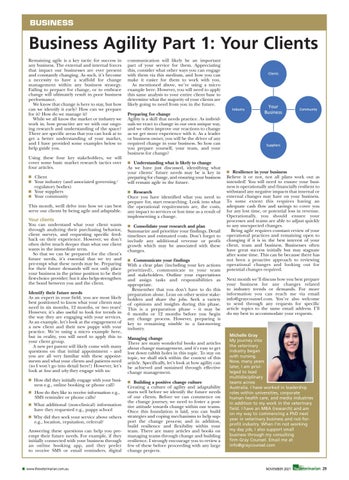BUSINESS
Business Agility Part 1: Your Clients Remaining agile is a key tactic for success in any business. The external and internal forces that impact our businesses are ever present and constantly changing. As such, it’s become a necessity to have a scaffold for change management within any business strategy. Failing to prepare for change, or to embrace change will ultimately result in poor business performance. We know that change is here to stay, but how can we identify it early? How can we prepare for it? How do we manage it? While we all know the market or industry we work in, how proactive are we with our ongoing research and understanding of the space? There are specific areas that you can look at to get a better understanding of your market, and I have provided some examples below to help guide you. Using these four key stakeholders, we will cover some basic market research tactics over four articles. ■ ■ ■ ■
Client Your industry (and associated governing/ regulatory bodies) Your suppliers Your community
This month, weíll delve into how we can best serve our clients by being agile and adaptable. Your clients You can understand what your client wants through analyzing their purchasing behavior, client surveys, and requesting specific feedback on their experience. However, we don’t often delve much deeper than what our client wants in the immediate term. So that we can be prepared for the client’s future needs, it’s essential that we try and pre-empt what these needs may be. Preparing for their future demands will not only place your business in the prime position to be their first-choice provider; but it also helps strengthen the bond between you and the client. Identify their future needs As an expert in your field, you are most likely best positioned to know what your clients may need in six months, 12 months, or two years! However, it’s also useful to look for trends in the way they are engaging with your services. As an example, let’s look at the engagement of a new client and their new puppy with your practice. We’re using a micro example here, but in reality, you will need to apply this to your client group. A new pet parent will likely come with many questions on that initial appointment -- and you are all very familiar with these appointments and what your clients and patients need (so I won’t go into detail here!) However, let’s look at how and why they engage with us: ■
How did they initially engage with your business e.g., online booking or phone call?
■
How do they like to receive information e.g., SMS reminder or phone calls?
■
What additional (non-clinical) information have they requested e.g., puppy school
■
Why did they seek your service above others e.g., location, reputation, referral?
Answering these questions can help you preempt their future needs. For example, if they initially connected with your business through an online booking app, and they prefer to receive SMS or email reminders, digital
■ www.theveterinarian.com.au
communication will likely be an important part of your service for them. Appreciating this, consider what other ways you can engage with them via this medium, and how you can make it easier for them to work with you. As mentioned above, we’re using a micro example here. However, you will need to apply this same analysis to your entire client base to determine what the majority of your clients are likely going to need from you in the future. Preparing for change Agility is a skill that needs practice. As individuals we react to change in our own unique way, and we often improve our reactions to change as we get more experience with it. As a leader or business owner, you will be the driver of any required change in your business. So how can you prepare yourself, your team, and your business for change? ■ Understanding what is likely to change As we have just discussed, identifying what your clients’ future needs may be is key in preparing for change, and ensuring your business will remain agile in the future. ■ Research Once you have identified what you need to prepare for, start researching. Look into what the operational requirements are, the costs, any impact to services or lost time as a result of implementing a change. ■ Consolidate your research and plan Summarize and prioritize your findings. Detail timelines and estimated costs. Don’t forget to include any additional revenue or profit growth which may be associated with these changes. ■ Communicate your findings With a clear plan (including your key actions prioritized), communicate to your team and stakeholders. Outline your expectations and assign tasks and responsibilities as appropriate. Remember that you don’t have to do this preparation alone. Lean on other senior stakeholders and share the jobs. Seek a variety of opinions and insights during this phase. This is a preparation phase -- it may be 6 months or 12 months before you begin any change process. However, preparing is key to remaining nimble in a fast-moving industry.
Managing change There are many wonderful books and articles about change management, and it’s easy to get lost down rabbit holes in this topic. To stay on topic, we shall stick within the context of this article. Specifically, let’s look at how agility can be achieved and sustained through effective change management. ■ Building a positive change culture Creating a culture of agility and adaptability starts well before we identify the future needs of our clients. Before we can commence on the change journey, we need to foster a positive attitude towards change within our teams. Once this foundation is laid, you can build strategies and coping mechanisms to help support the change process; and in addition, build resilience and flexibility within your team. There are many articles and books on managing teams through change and building resilience. I strongly encourage you to review a few of these before proceeding with any large change projects.
■ Resilience in your business Believe it or not, not all plans work out as intended! You will need to ensure your business is operationally and financially resilient to withstand any negative impacts that internal or external changes may have on your business. To some extent this requires having an adequate cash flow and savings to cover you for any lost time, or potential loss in revenue. Operationally, you should ensure your processes and teams are able to adjust quickly to any unexpected changes. Being agile requires constant review of your operational practices and remaining open to changing if it is in the best interest of your client, team and business. Businesses often have great success initially but may stagnate after some time. This can be because there has not been a proactive approach to reviewing operational changes and looking out for potential changes required.
Next month we’ll discuss how you best prepare your business for any changes related to industry trends or demands. For more information you can reach me via email info@graycounsel.com. You’re also welcome to send through any requests for specific article topics to the same email address. I’ll do my best to accommodate your requests.
Michelle Gray My journey into the veterinary industry began with nursing. Now, many years later, I am privileged to lead multidisciplinary teams across Australia. I have worked in leadership roles within universities, corporate human health care, and media industries in addition to my work in the veterinary field. I have an MBA (research) and am on my way to commencing a PhD next year in veterinary business and not-forprofit industry. When I’m not working my day job, I also support small business through my consulting firm Gray Counsel. Email me at info@graycounsel.com
NOVEMBER 2021 TheVeterinarian 29






